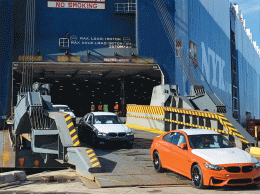
For the past 20 years, the Port of Hueneme has been a place of big dreams and lowered expectations.
The only deepwater harbor between Los Angeles and San Francisco has carved out a valuable space as a clearinghouse for moving fresh vegetables and automobiles. But without the big overhead cranes that make the ports of Long Beach and Los Angeles the superstars of globalization, it remains a much smaller player in trans-Pacific trade.
During the recession, the Port of Hueneme saw volumes drop and red ink flow amid a worldwide slump in auto imports. And getting projects for manufacturers, notably Volkswagen, built near the Port’s vehicle processing facilities have been difficult.
But thanks in part to energetic leadership under Executive Director Kristin Decas, things have started to turn around for the Port and its governing body, Oxnard Harbor District.
The port set record trade volumes for the past year, the auto business is back, and now the district board of commissioners is beginning to plot a path for the future. It has avoided many of the contentious labor battles that give the bigger SoCal ports a black eye and instead focused on productivity.
Under construction is a new plug-in facility that will provide shore side power to ships at birth, eliminating tons of pollution from diesel engines.
And at a working session on July 23, the District unveiled a new strategic plan for connecting to businesses in the region. Gone is the logo that leaves the impression that Port of Hueneme is simply a little Long Beach.
Instead a green and yellow “H” shows that the port is a specialist in the business of shipping agricultural products and that it has solid environmental credentials. “We make cargo move,” is the port’s new tagline.
In a talk outlining the new strategic plan, consultant John Martin said the Port of Hueneme can prosper by differentiating itself from Long Beach and Los Angeles and focusing on specialized niche markets.
Those markets include agribusiness, liquids, fresh seafood and vehicles. More important is to provide a way to let shippers in California and beyond know that the port is there and that it has better credentials than its rivals when it comes to productivity. Martin told me he thinks there are plenty of potential shippers from Santa Barbara through Ventura County who don’t even know the port exists, let alone the fact that it is a viable alternative to Los Angeles and Long Beach.
In some ways, the port is going back to its roots in the late 19th century, when it was built as a way to move Central Coast agricultural products into the global economy. Just as Ventura County’s agribusinesses have moved from lima beans and bulk crops to high-value specialty citrus, berries and avocados, the Port is starting to reposition itself as a place that focuses on serving “vital niche markets.”
The port’s campaign to raise its profile began earlier this year with an economic impact study that pegged its overall impact at roughly $1 billion and 9,448 jobs. Combined with the new marketing and green practices, it’s got an impressive start.
But the future will be about seizing opportunities and making smart capital investments. That’s a challenge any enterprise — even a port — should relish.
• Contact Editor Henry Dubroff at hdubroff@pacbiztimes.com.






 Print
Print Email
Email
















